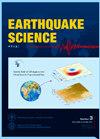High-quality control of receiver functions using a capsule neural network
IF 4.1
4区 地球科学
Q3 Earth and Planetary Sciences
引用次数: 0
Abstract
The Red Sea-Gulf of Suez-Cairo-Alexandria Clysmic-Trend in northern Egypt is the main earthquake zone in the country, with a moderate-to-high seismic hazard and a history of significant earthquakes caused by rifting and active faulting. To improve our understanding of the tectonic and seismic processes in this area, more comprehensive imaging of the crustal structure is required. This can be achieved by increasing the number of receiver functions (RFs) recorded by the seismic stations in northern Egypt and the southeastern Mediterranean. Data handling and processing should also be automated to increase process efficiency. In this study, we developed a capsule neural network for automated selection of RFs. The model was trained on a dataset containing RFs (both selected and unselected) from five broadband stations in northern Egypt. Stations SLM, SIWA, KOT, NBNS, and NKL are located in the unstable shelf region of Egypt, where limited knowledge of the deep crustal structure is available. The proposed capsule neural network achieved an average precision of 80% on the test set. The automated selection of RFs using a capsule neural network has the potential to significantly improve the efficiency and accuracy of RF analysis, as demonstrated by the stacking test. This could lead to a better understanding of crustal structure and tectonic processes in northern Egypt and the southeastern Mediterranean.
高质量的控制接收函数使用胶囊神经网络
埃及北部的红海-苏伊斯湾-开罗-亚历山大港-克莱斯韦特是该国的主要地震带,具有中高地震危险性,并且有由裂谷和活动断层引起的重大地震的历史。为了提高我们对该地区构造和地震过程的认识,需要对地壳结构进行更全面的成像。这可以通过增加埃及北部和地中海东南部地震台站记录的接收函数(rf)的数量来实现。数据处理和处理也应该自动化,以提高流程效率。在这项研究中,我们开发了一个胶囊神经网络,用于自动选择rf。该模型是在包含来自埃及北部五个宽带站的rf(包括选定的和未选定的)数据集上进行训练的。SLM、SIWA、KOT、NBNS和NKL台站位于埃及不稳定陆架区,对地壳深部结构的了解有限。所提出的胶囊神经网络在测试集上的平均精度达到80%。正如堆叠测试所证明的那样,使用胶囊神经网络自动选择RF有可能显著提高RF分析的效率和准确性。这将有助于更好地了解埃及北部和地中海东南部的地壳结构和构造过程。
本文章由计算机程序翻译,如有差异,请以英文原文为准。
求助全文
约1分钟内获得全文
求助全文
来源期刊

Earthquake Science
GEOCHEMISTRY & GEOPHYSICS-
CiteScore
1.10
自引率
8.30%
发文量
42
审稿时长
3 months
期刊介绍:
Earthquake Science (EQS) aims to publish high-quality, original, peer-reviewed articles on earthquake-related research subjects. It is an English international journal sponsored by the Seismological Society of China and the Institute of Geophysics, China Earthquake Administration.
The topics include, but not limited to, the following
● Seismic sources of all kinds.
● Earth structure at all scales.
● Seismotectonics.
● New methods and theoretical seismology.
● Strong ground motion.
● Seismic phenomena of all kinds.
● Seismic hazards, earthquake forecasting and prediction.
● Seismic instrumentation.
● Significant recent or past seismic events.
● Documentation of recent seismic events or important observations.
● Descriptions of field deployments, new methods, and available software tools.
The types of manuscripts include the following. There is no length requirement, except for the Short Notes.
【Articles】 Original contributions that have not been published elsewhere.
【Short Notes】 Short papers of recent events or topics that warrant rapid peer reviews and publications. Limited to 4 publication pages.
【Rapid Communications】 Significant contributions that warrant rapid peer reviews and publications.
【Review Articles】Review articles are by invitation only. Please contact the editorial office and editors for possible proposals.
【Toolboxes】 Descriptions of novel numerical methods and associated computer codes.
【Data Products】 Documentation of datasets of various kinds that are interested to the community and available for open access (field data, processed data, synthetic data, or models).
【Opinions】Views on important topics and future directions in earthquake science.
【Comments and Replies】Commentaries on a recently published EQS paper is welcome. The authors of the paper commented will be invited to reply. Both the Comment and the Reply are subject to peer review.
 求助内容:
求助内容: 应助结果提醒方式:
应助结果提醒方式:


